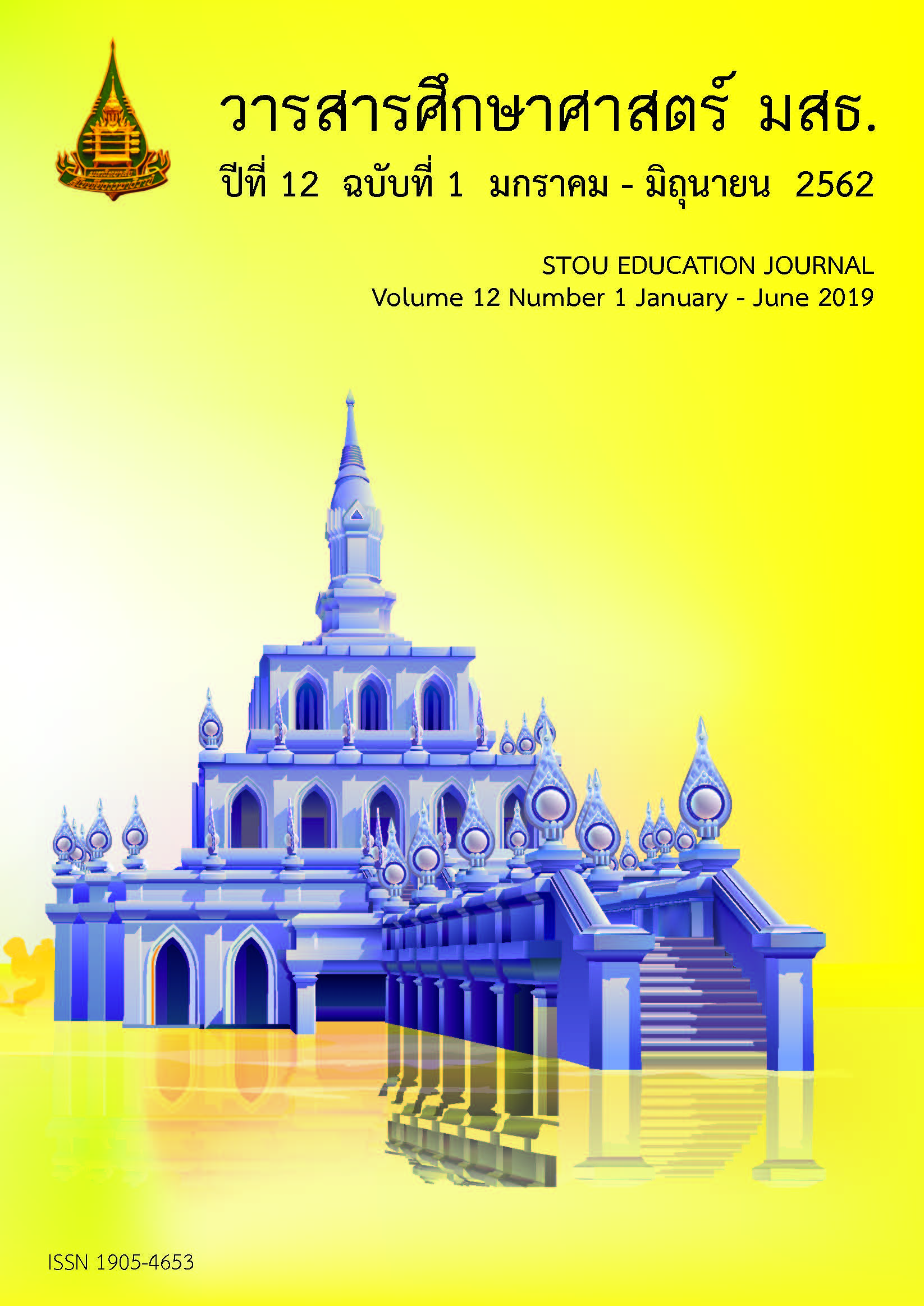การพัฒนารูปแบบการจัดการเรียนรู้เพื่อส่งเสริมการคิดเชิงคณิตศาสตร์ สำหรับนักเรียนชั้นมัธยมศึกษาปีที่ 4
Main Article Content
บทคัดย่อ
การวิจัยในครั้งนี้มีวัตถุประสงค์เพื่อพัฒนารูปแบบการจัดการเรียนรู้เพื่อส่งเสริมการคิดเชิงคณิตศาสตร์สำหรับนักเรียนชั้นมัธยมศึกษาปีที่ 4 โดยขั้นตอนในการพัฒนาประกอบด้วย 3 ขั้นตอนคือ 1) การสังเคราะห์เอกสารและงานวิจัยที่เกี่ยวข้อง 2) การยกร่างและพัฒนารูปแบบการจัดการเรียนรู้เพื่อส่งเสริมการคิดเชิงคณิตศาสตร์สำหรับนักเรียนชั้นมัธยมศึกษาปีที่ 4 และ 3) การประเมินความเหมาะสมของรูปแบบการจัดการเรียนรู้ ผู้ให้ข้อมูลสำคัญคือผู้เชี่ยวชาญด้านคณิตศาสตร์ศึกษาและด้านการจัดการเรียนรู้คณิตศาสตร์ 5 คน โดยใช้แบบประเมินความเหมาะสมของรูปแบบการจัดการเรียนรู้เพื่อส่งเสริมการคิดเชิงคณิตศาสตร์สำหรับนักเรียนชั้นมัธยมศึกษาปีที่ 4 ทำการวิเคราะห์ข้อมูลการวิจัยโดยใช้ การวิเคราะห์เนื้อหา ค่าเฉลี่ย และส่วนเบี่ยงเบนมาตรฐาน ผลการวิจัยปรากฏว่า รูปแบบการจัดการเรียนรู้เพื่อส่งเสริมการคิดเชิงคณิตศาสตร์ประกอบด้วย 7 องค์ประกอบ ได้แก่ (1) หลักการของรูปแบบการจัดการเรียนรู้ (2) วัตถุประสงค์ของรูปแบบการจัดการเรียนรู้ (3) กระบวนการเรียนการสอนของรูปแบบการจัดการเรียนรู้ (4) การวัดและประเมินผลของรูปแบบการจัดการเรียนรู้ (5) บรรยากาศการเรียนรู้ (6) บทบาทของครูผู้สอน (7) บทบาทของนักเรียน ซึ่งกระบวนการเรียนการสอนของรูปแบบการจัดการเรียนรู้มี 5 ขั้น คือ (1) ขั้นทบทวนความรู้เดิม (2) ขั้นเรียนรู้จากการปฏิบัติ
(3) ขั้นแลกเปลี่ยนเรียนรู้ (4) ขั้นสร้างความรู้ และ (5) ขั้นนำไปใช้ ผลการประเมินความเหมาะสมของรูปแบบการจัดการเรียนรู้พบว่า รูปแบบการจัดการเรียนรู้เพื่อส่งเสริมการคิดเชิงคณิตศาสตร์สำหรับนักเรียนชั้นมัธยมศึกษาปีที่ 4 มีความเหมาะสมในระดับมาก
Article Details
เอกสารอ้างอิง
กระทรวงศึกษาธิการ. (2552). หลักสูตรแกนกลางการศึกษาขั้นพื้นฐาน พุทธศักราช 2551. กรุงเทพมหานคร: สำนักงานคณะกรรมการการศึกษาขั้นพื้นฐาน กระทรวงศึกษาธิการ.
ทิศนา แขมมณี. (2551). ศาสตร์การสอน: องค์ความรู้เพื่อการจัดกระบวนการเรียนรู้ที่มีประสิทธิภาพ. (พิมพ์ครั้งที่ 7). กรุงเทพฯ: ด่านสุทธาการพิมพ์.
บุญชม ศรีสะอาด. (2556). การวิจัยเบื้องต้น. (พิมพ์ครั้งที่ 9). กรุงเทพฯ: สุวีริยาสาส์น.
ปฏิมา พุฒตาลดง. (2558). การพัฒนารูปแบบการจัดการความรู้ของวิทยาลัยสารพัดช่างในเขตภาคเหนือตอนล่าง. วารสารเครือข่ายบัณฑิตศึกษามหาวิทยาลัยราชภัฏภาคเหนือ, 7(ฉบับพิเศษ). 69- 84.
ประพันธ์ศิริ สุเสารัจ. (2556). การพัฒนาการคิด. (พิมพ์ครั้งที่ 3). กรุงเทพมหานคร: 9119 เทคนิคพริ้นติ้ง.
พรรณี ชูทัย เจนจิต. (2550). จิตวิทยาการเรียนการสอน. กรุงเทพฯ: เกรท เอ็ดดูเคชั่น.
พัชรี ปิยภัณฑ์. (2555). การพัฒนารูปแบบการจัดการเรียนรู้เพื่อส่งเสริมความสามารถในการแก้ปัญหาทางคณิตศาสตร์ สำหรับนักเรียนชั้นมัธยมศึกษาปีที่ 3. (ปริญญานิพนธ์ การศึกษาดุษฎีบัณฑิต สาขาการวิจัยและพัฒนาหลักสูตร ไม่ได้ตีพิมพ์). บัณฑิตวิทยาลัย มหาวิทยาลัยศรีนครินทรวิโรฒ, กรุงเทพมหานคร.
ยุพิน พิพิธกุล. (2530). การสอนคณิตศาสตร์. กรุงเทพฯ: ภาควิชาการมัธยมศึกษา จุฬาลงกรณ์มหาวิทยาลัย.
รุ่งทิวา นาบำรุง. (2550). วิถีธรรมชาติแห่งการคิดเชิงคณิตศาสตร์เรื่องการคูณและการหารของเด็กที่มีอายุตั้งแต่ 7-10 ปี . (วิทยานิพนธ์ปริญญาดุษฎีบัณฑิต สาขาวิชาคณิตศาสตร์ศึกษา ไม่ได้ตีพิมพ์). มหาวิทยาลัยศรีนครินทรวิโรฒ, กรุงเทพมหานคร.
ฤทัยรัตน์ ลอยเจริญ. (2558). การพัฒนารูปแบบการสอนอ่านโดยใช้ยุทธวิธีเมตาคอกนิชันเพื่อเสริมสร้างความเข้าใจระดับสูงในการอ่านภาษาไทยของนักเรียนชั้นประถมศึกษา. วารสารศึกษาศาสตร์ มสธ., 8(2), 131-148.
สถาบันส่งเสริมการสอนวิทยาศาสตร์และเทคโนโลยี. ( 2557). ผลการประเมิน PISA 2012 คณิตศาสตร์ การอ่าน และวิทยาศาสตร์ นักเรียนรู้อะไร และทำอะไรได้บ้าง. กรุงเทพฯ: ห้างหุ้นส่วนจำกัด อรุณการพิมพ์.
สถาบันส่งเสริมการสอนวิทยาศาสตร์และเทคโนโลยี. (2555). การวัดและประเมินผลคณิตศาสตร์. กรุงเทพฯ: วี. พริ้น (1991).
สุทินันท์ บุญพัฒนาภรณ์. (2558). การพัฒนากระบวนการจัดการเรียนรู้เพื่อส่งเสริมการคิดเชิงคณิตศาสตร์ สำหรับนักเรียนชั้นมัธยมศึกษา. วารสารวิชาการอุตสาหกรรมศึกษา, 9(2), 109-122.
สุวิทย์ แบ่งทิศ. (2560). การพัฒนารูปแบบการสอนคณิตศาสตร์เพื่อเสริมสร้างความสามารถด้านการคิดอย่างมีวิจารณญาณ สำหรับนักเรียนชั้นมัธยมศึกษาปีที่ 6. วารสารเครือข่ายบัณฑิตศึกษามหาวิทยาลัยราชภัฎภาคเหนือ, 7(12), 103-116.
อัมพร ม้าคนอง. (2546). คณิตศาสตร์: การสอนและการเรียนรู้. ศูนย์ตำราและเอกสารทางวิชาการ คณะครุศาสตร์ จุฬาลงกรณ์มหาวิทยาลัย.
National Council of Teachers of Mathematics (NCTM). (2000). Principles and standards for school mathematics. USA: NCTM.
Rickart, C. (1996). Structuralism and mathematical thinking. In The Nature of Mathematical Thinking. In Sternberg, R.J. & Ben-Zeev, T.(Eds.), The mathematical thinking (pp. 285-300). NJ: Lawrence Erlbaum Associates.
Stacy, K. (2016). What is mathematical thinking and why is it important. Retrieved from http://www.criced.tsukuba.ac.jp/math/apec/apec/2007/paper_pdf/Kaye%20Stacey. pdf. May 8, 2016.


